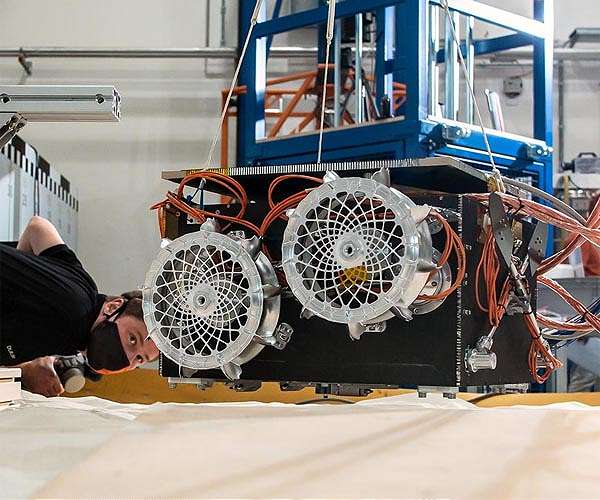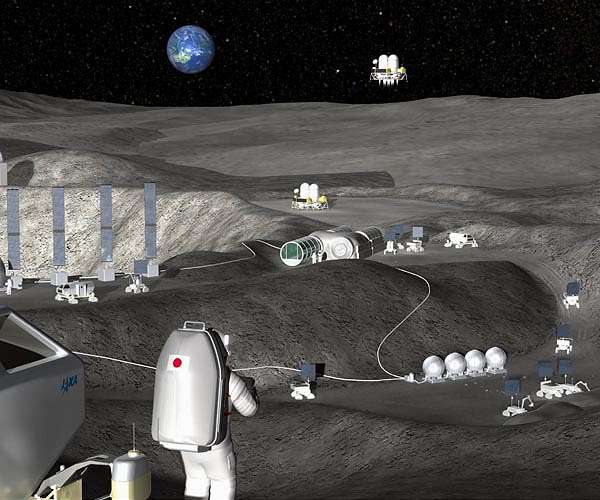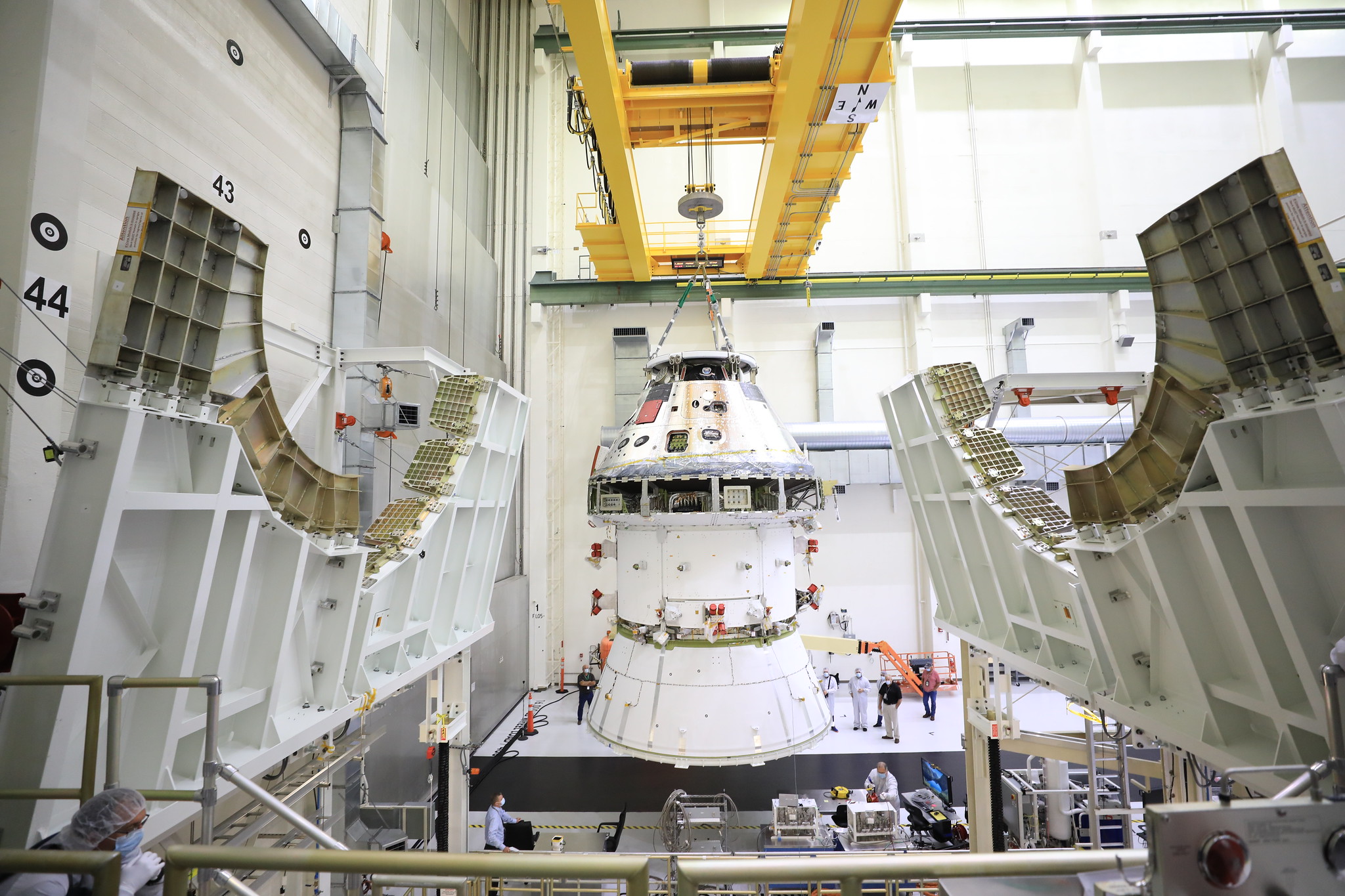Install the app
How to install the app on iOS
Follow along with the video below to see how to install our site as a web app on your home screen.
Note: This feature may not be available in some browsers.
You are using an out of date browser. It may not display this or other websites correctly.
You should upgrade or use an alternative browser.
You should upgrade or use an alternative browser.
Avaruus
- Viestiketjun aloittaja Juke
- Aloitus PVM
The Japan Aerospace Exploration Agency (JAXA) Martian Moons eXploration (MMX) mission will have a German-French rover on board when it is launched in 2024. The rover will land on the Martian moon Phobos and explore its surface for approximately three months. Initial landing tests are currently underway at the German Aerospace Center Landing and Mobility Test Facility (Lande- und Mobilitaetstest Anlage; LAMA) in Bremen. Using a first preliminary development model, the engineers are determining how robust the design of the approximately 25-kilogram rover must be to withstand an impact on the moon's surface after a free fall of about 40 to 100 metres.
"Under laboratory conditions, we drop the preliminary model of the MMX Rover from a height of five centimetres onto a changeable surface at various angles," explains Test Manager Michael Lange from the DLR Institute of Composite Structures and Adaptive Systems. "In this way, since Phobos has only approximately two thousandths of Earth's gravity at its surface, we can simulate the intensity of the impact for the rover structure."
A particular challenge is that the free-falling rover could arrive at the surface in any orientation, possibly also hitting a rock. "To simulate this situation, we are using two hemispheres with diameters of two and nine centimetres that are positioned in a bed of sand, in addition to a flat plate," says Michael Wrasmann from the DLR Institute of Space Systems. "The exact location of the landing on the surface of Phobos is a matter of chance and we are using these analyses to prepare for the various possible scenarios."

First tests for landing the Martian Moons eXploration Rover
Berlin, Germany (SPX) Oct 01, 2020 - The Japan Aerospace Exploration Agency (JAXA) Martian Moons eXploration (MMX) mission will have a German-French rover on board when it is launched in 2024. The rover will land on the Martian moon Ph
www.spacedaily.com
tulikomento
Supreme Leader
The project for a top-notch station, Gateway, is a would-be collaboration with the US, and has already driven the Japanese space agency to apply for hefty government funding - around $2.7 billion yearly for the next 15 years.
The Japan Aerospace Exploration Agency (JAXA) has asserted it intends to engage in a lunar exploration mission beginning in the mid-2030s, making use of hydrogen fuel that would be locally produced right on the Moon's surface from water extracted from its vast ice deposits, The Japan Times reported.
Making use of local water and water-derived fuel is expected to cost significantly less than transporting the needed amount of water from Earth. According to JAXA's estimates, 37 tonnes of water will be necessary for a trip to and from the Gateway, a lunar orbit space station that is to be built jointly with the US. Overall, five to seven such missions are planned.
While the station itself is expected to be erected in the 2020s, the lunar south pole, researchers hope, will see a fuel factory built there years later, by around 2035.
JAXA has projected that the fuel will be used in a reusable spacecraft tasked with carrying four astronauts to and from Gateway, and a transport vehicle that can travel up to 1,000 kilometres along the Moon's surface, which has low gravity - a feature that will make the transport vehicle be wheel-less, but rather hop across the land.
The science ministry plans to request a record high 280 billion yen ($2.7 billion) for JAXA in its budget inquiry for the next fiscal year. Over the past ten years, the ministry's annual funds have not exceeded 190 billion yen ($1.8 billion).
Not only the US and Japan have been expressing an intention to dig further for water resources on the Moon. China, which has already landed an unmanned spacecraft on the lunar surface, is planning to send a probe to the Moon later this year to collect soil samples.
Independently, Russian space industry giant Korolev Rocket and Space Corporation Energia has recently created and patented a means to fly cosmonauts to the Moon and back without an expensive new heavy-launch rocket. To land cosmonauts on the Moon and bring them back home, the patented system requires one Soyuz-2.1a rocket and three upgraded Angara A5V rockets.
Russia's State Corporation for Space Activities (Roscosmos) envisions launching a manned flight to the Moon by 2030, according the agency's chief, Dmitriy Rogozin, who recently referred to China as the most likely partner for Russia to create a brand new base on Earth's natural satellite.

Japan aiming to send hopping spacecraft fuelled by lunar water to Moon
Moscow (Sputnik) Sep 30, 2020 - The project for a top-notch station, Gateway, is a would-be collaboration with the US, and has already driven the Japanese space agency to apply for hefty government funding - around $2.7 billion ye
www.moondaily.com
Rocket Factory Augsburg Signs Agreement with Andøya Space for maiden launch
28.09, 2020Rocket Factory Augsburg AG (RFA), the leading launch service provider based in Germany, signed a ground breaking MoU with Norway based Andøya Space, to implement a launch site for the RFA ONE launch system to provide end-to-end launch services for small satellites.
Saksalainen ääliöstartup yrittää laukoa raketteja napapiirin tietämiltä. Öhöhöh, piirrettäiskö pilakuva? Rakentaisivat paperikoneita!
Tutkijat löysivät planeetan, joka voi olla maapalloakin suotuisampi elämälle

 www.hs.fi
www.hs.fi

Avaruus | Tutkijat löysivät planeetan, joka voi olla maapalloakin suotuisampi elämälle
Tutkijat kartoittivat tunnetuista eksoplaneetoista 24 mahdollista ”paratiisia”, joissa elämä voisi kukoistaa vielä monipuolisemmin kuin täällä.
Fremen
Greatest Leader
Lyhyt yhteenveto (siis abstract) Prof. R. Penrosen Nobeliin liittyen..
.pdf on ilmainen.

 academic.oup.com
academic.oup.com
Apparent evidence for Hawking points in the CMB Sky
.pdf on ilmainen.

Apparent evidence for Hawking points in the CMB Sky★
ABSTRACT. This paper presents strong observational evidence of numerous previously unobserved anomalous circular spots, of significantly raised temperature
Tyylikkäitä nämä entisajan avaruusukot. Auto oli tosin Ranskan valtion lahja. "world's first rear mid-engined production road car"

 en.wikipedia.org
Tuota jos olisi lisenssillä tehty sielä niin nimeksi olisi sopinut Matra Njet.
en.wikipedia.org
Tuota jos olisi lisenssillä tehty sielä niin nimeksi olisi sopinut Matra Njet.

Matra Djet - Wikipedia
Tyylikkäitä nämä entisajan avaruusukot. Auto oli tosin Ranskan valtion lahja. "world's first rear mid-engined production road car"
Tuota jos olisi lisenssillä tehty sielä niin nimeksi olisi sopinut Matra Njet.
Matra Djet - Wikipedia
en.wikipedia.org
Hetken aikaa luulin, että se yksi neukku-vitsi olisikin ollut totta, mutta auto onkin Ranskalaisten, eikä neukkujen lahja.
Ruotsi aloittaa satelliittien ampumisen ilmaan.
The Swedish space base Esrange outside Kiruna will start launching satellites. This was announced by the Minister for Higher Education and Research, Matilda Ernkrans (S) on Wednesday afternoon.
The government has decided on a state part-financing of a total of SEK 90 million, money that will enable a new rocket launching ramp.
- We know that it provides jobs here and now, it will attract new high-tech companies to Norrbotten but also to other parts of Sweden where we have a strong space industry, and it will continue to develop our already strong space research, says Matilda Ernkrans to TT, according to SvD .
The satellite launches from Esrange will be the first of their kind from European soil, and Sweden will thus be part of the group of just over ten countries that possess this type of capacity, reports Swedish Radio .
Satellites from Esrange are expected to be sent out from 2022.
Ruotsi aloittaa satelliittien ampumisen ilmaan.
Minua yhä enemmän korpeaa Kulmunin ääliömäinen tuomitseminen, enkä ole edes kepulainen tai Kulmuni-fani (paitsi ulkonäön puolesta).
tulikomento
Supreme Leader
Asiaa pakoraketeista.
fulcrum
Greatest Leader
Sama vika Rahikaisella...ei nyt ihan samaa tasoa, mutta ysärin alussa eräät neropatit halusivat myydä Nokian teletoiminnan pois "koska suomalainen yritys ei voisi ikinä kilpailla niin kansainvälisellä alalla". Parempi tyytyä keittämään sellua, muuta on turha yrittää.Minua yhä enemmän korpeaa Kulmunin ääliömäinen tuomitseminen, enkä ole edes kepulainen tai Kulmuni-fani (paitsi ulkonäön puolesta).
tulikomento
Supreme Leader
Kustaanmiekka
Kenraali
Nokia pääsee rakentamaan ensimmäisen kännykkäverkon Kuuhun
Yhdysvaltain ilmailu- ja avaruushallintovirasto NASA valitsi Nokian kumppanikseen rakentamaan mobiiliverkkoa Kuuhun.
Nokia pääsee rakentamaan ensimmäisen kännykkäverkon Kuuhun
Yhdysvaltain ilmailu- ja avaruushallintovirasto NASA valitsi Nokian kumppanikseen rakentamaan mobiiliverkkoa Kuuhun.Yhdysvaltain ilmailu- ja avaruushallintovirasto NASA on valinnut Nokian rakentamaan ensimmäisen mobiiliverkon Kuuhun.
Nokian tiedotteen mukaan viestintä on tärkeä osa NASAn Artemis-ohjelmaa, jonka tarkoituksena on luoda pysyvät olosuhteet Kuuhun vuosikymmenen loppuun mennessä.
Kuuhun on tulossa 4G-verkko. Nokian mukaan verkko sovetuu hyvin astronauttien kaikkiin tarpeisiin.
Verkossa voidaan lähettää ääntä ja videokuvaa ja toimittaa muun muassa kaukomittauksia ja biometrisiä tietoja sekä ohjata robotteja.
Verkko rakennetaan vuoden 2022 lopulla.
– Luotettava, kestävä ja suuren kapasiteetin viestintäverkko on avainasemassa, jotta ihmisen pysyvä oleskelu Kuun olosuhteissa onnistuu, Nokian teknologiajohtaja Marcus Weldon sanoo tiedotteessa.
Ratkaisu on tiedotteen mukaan suunniteltu kestämään laukaisun ja Kuuhun laskeutumisen kovat olosuhteet ja toimimaan avaruuden vaativissa olosuhteissa.
Kustaanmiekka
Kenraali
Nokia nappasi 12 miljoonan euron rahoituksen: Kuussa toimii pian 4g-verkko
Järjestelmä mahdollistaa Kuussa tapahtuvan kommunikaation toteutumisen kauemmas, nopeammin ja luotettavammin.
Nokia nappasi 12 miljoonan euron rahoituksen: Kuussa toimii pian 4G-verkko
Nokia aloittaa Nasan kanssa yhteistyön, jossa rakentaa Kuuhun toimivan 4g-verkon. Suomalainen yhtiö saa Nasalta noin 12 miljoonan euron rahoituksen projektia varten, XDA-Developers kertoo.
Nokian saama rahoitus on yksi yhteensä yli 300 miljoonan euron arvoisista sopimuksista, joiden avulla Nasa pyrkii pääsemään takaisin kuuhun vuoteen 2024 mennessä.
Sopimuksen on saanut Nokian Yhdysvaltojen osasto, mutta sen toteutumiseen tarvitaan koko yhtiön osallistumista.
Järjestelmä mahdollistaa Kuussa tapahtuvan kommunikaation toteutumisen kauemmas, nopeammin ja luotettavammin, Nasa kertoi sopiessaan yhteistyöstä.
Kuuhun tulevaa 4g-verkkoa käyttävät astronautit, ajoneuvot ja tulevaisuudessa rakennettavat kuutukikohdat.
”Nasan rahoituksen avulla Nokia tutkii miten maanpäällisen teknologian voi muuttaa Kuuhun sopivaksi luotettavasti ja hyvälaatuisella lopputuloksella”, Nasan edustaja Jim Reuter kertoo.
rty19
Greatest Leader
PR-arvo paljon suurempi kuin tuo 12 miljoonaa.Siistiä - vaikkei sopimus olekaan kovin rahakas ja olenkohan väärässä jos veikkaan ettei kauheita voittomarginaaleja tule. Varmaan ollut hyvin haluttu diili.
Leaderwolf
Respected Leader
-Yara tykkäsi viestistäsi-
Fosfaatti on aina ollut datassa mukana mutta kukaan ei ajatellut sen olevan mahdollista.

